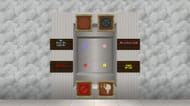Minecraft is a game with a history that spans well over a decade. Its prototypes were developed in 2009 when it was still known as "Cave Game." Since those days, the beloved sandbox title has expanded to a multimedia franchise, and the main game is still played by millions worldwide. Moreover, free content updates have introduced massive numbers of blocks and items.
On the subject of blocks, some have a long and storied history that dates back to Minecraft's earliest days. They may have undergone some changes since then, but they're still the same blocks at their core.
For Minecraft fans curious about the game's long history, it doesn't hurt to take a look at the oldest blocks in the beloved sandbox survival title.
Note: Some aspects of this article are subjective and reflect the opinions of the writer
Chart New Territories with the ultimate Minecraft Seed Generator!
Ranking the 10 oldest blocks in Minecraft's history
10) Lava

As a fluid, some Minecraft players may not think that lava is considered a block. However, underneath the hood of the game, it is classified as such and is given properties that confirm it as such.
Lava arrived in the 0.0.12 alpha, which now falls under what is considered the game's Classic era. Since then, it has been a useful resource and a dangerous hazard. It has become a unanimous topic of discussion among players for its applications and creative uses.
9) Water

Much like lava, even though water is a fluid, it is categorized as a block in Minecraft. Water made its way to the series in the 0.0.12 alpha alongside the likes of lava and bedrock. Since then, it has seen plenty of revisions, including biome-specific coloration, countless structures, and mobs inhabiting oceans.
Water wasn't much in the earliest days of Minecraft, but this has certainly changed in a big way since then.
8) Bedrock

Bedrock blocks have remained the literal foundation of Minecraft worlds since the 0.0.12 alpha and even have their own edition of the game named after them. Nonetheless, they are well-known for their near-imperviousness and for being found at the lowest levels of in-game worlds across all three dimensions.
Fortunately, bedrock blocks have their functions, but players will have to use Creative Mode or commands to harness them as a resource since they can't be mined under normal circumstances in vanilla Survival Mode.
7) Oak saplings

The first tree saplings, which would later become known as oak saplings, arrived in the Pre-Classic release known as pc-161148 with a very barebones in-game texture, one that Notch said he didn't like. This would ultimately lead to oak saplings being retextured.
Back in its Pre-Classic release, trees weren't naturally found in Minecraft worlds. Therefore, saplings didn't have much use, though this was obviously addressed later on.
6) Planks

Much like oak saplings, wooden planks arrived in the beloved sandbox title well before trees were generated in worlds. As a matter of fact, when this block arrived in the pc-152225 release, it wasn't categorized as wooden at all and was just referred to as "planks."
Nowadays, planks come in a ton of varieties thanks to the different forms of wood available in the game. However, it's fun to look back on where the block began.
5) Cobblestone

Before bedrock lined the deepest parts of Minecraft's worlds, they were inhabited by grass, dirt, stone, and cobblestone. The latter came along in the pc-152225 prototype and grew to be one of the most oft-used blocks in the game's history, maybe even the most used of all time.
Cobblestone had its appearance changed since the prototype era, but it remains one of the most unanimously appreciated blocks in the sandbox title to this day.
4) Dirt

Dirt blocks surfaced in Minecraft in the pc-152225 prototype, making them among the first blocks in the game. However, they were still preceded by grass blocks by one update.
Be that as it may, even back in the prototype era, dirt blocks still had some of the abilities that they possess today. This includes the fact that in early prototypes, dirt blocks could be converted into grass blocks by being placed next to them.
3) Stone

What would Minecraft be without stone? Probably a very different game. Nonetheless, stone is one of the three oldest blocks in the sandbox title, debuting in pc-131334, which was otherwise known as the "Cave Game tech test/demo" well before the official name of the game was surmised.
Compared to many old blocks, stone has remained resilient and consistent. It hasn't changed all that much over the course of the sandbox sensation's history. However, there's not exactly anything wrong with that; the block gets the job done just the way it is.
2) Grass

Back in the earliest tech demo of Cave Game, grass essentially covered all of the game world. Although Minecraft worlds, as fans know them, are now composed of many more blocks, grass remains a constant in the Overworld.
Nonetheless, grass is the oldest solid block in the game alongside stone, but it originally looked a bit different. Specifically, it used to be green on all sides of its block texture. This was ultimately changed in later updates as the title took shape, and it was mixed with the dirt block texture.
1) Air

When the Cave Game tech demo became playable, Notch didn't even consider air to be a block. However, it was present in a block-based capacity nonetheless and served as the pure foundation that all other blocks existed within. Mojang would go on to classify air as a block later on, making it the oldest in the game's tenure.
The funny thing is that since it's invisible and non-solid, most players today still don't even think about air as a block. However, through the use of commands or mods, it's still possible to interact with air in some capacity that isn't often thought of.
Uncover new worlds with our Minecraft Seed Generator!

